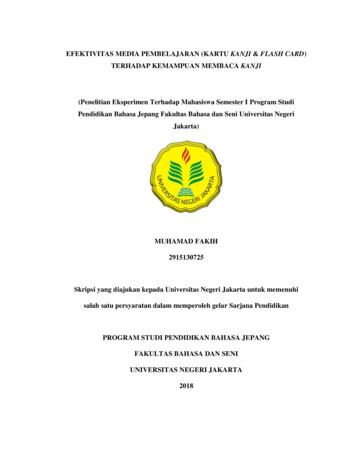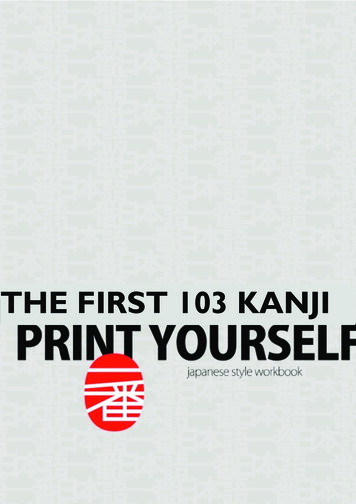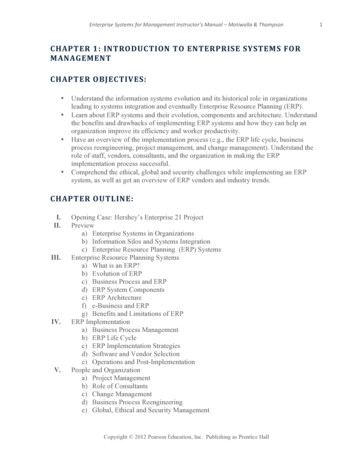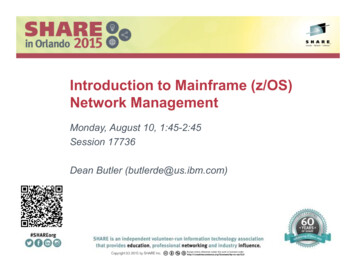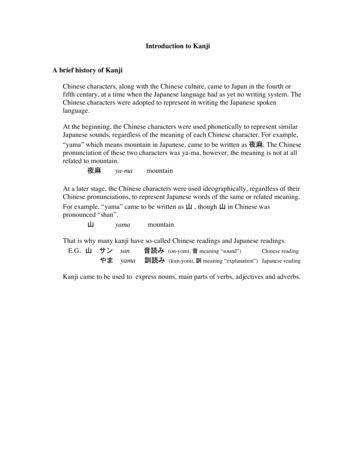
Transcription
Introduction to KanjiA brief history of KanjiChinese characters, along with the Chinese culture, came to Japan in the fourth orfifth century, at a time when the Japanese language had as yet no writing system. TheChinese characters were adopted to represent in writing the Japanese spokenlanguage.At the beginning, the Chinese characters were used phonetically to represent similarJapanese sounds, regardless of the meaning of each Chinese character. For example,“yama” which means mountain in Japanese, came to be written as . The Chinesepronunciation of these two characters was ya-ma, however, the meaning is not at allrelated to mountain. ya-mamountainAt a later stage, the Chinese characters were used ideographically, regardless of theirChinese pronunciations, to represent Japanese words of the same or related meaning.For example, “yama” came to be written as , though in Chinese waspronounced “shan”. yamamountainThat is why many kanji have so-called Chinese readings and Japanese readings.E.G san(on-yomi, meaning “sound”)Chinese reading yama (kun-yomi, meaning “explanation”) Japanese readingKanji came to be used to express nouns, main parts of verbs, adjectives and adverbs.
Why do Japanese kanji have more than one pronunciation?As explained above, many kanji have Chinese & Japanese readings. Thepronunciations of Chinese characters were different depending on the periods andregions in China from which they were adopted. Over time, the Japanese peopleadopted three pronunciations as Chinese readings for the Japanese kanji. They arecalled (go sound) (kan sound) and (tou sound). (go sound) is the pronunciation used in the (Wu) region around the lowerYangtze River during the Southern & Northern Dynasties. These pronunciationswere brought to Japan by the 6th century. (kan sound) is the pronunciation used in the northwest region during the T’angDynasty. They were brought to Japan by the Japanese delegations sent to the T’angcourt during the 7th 9th century. (tou sound, it is sometimes called sou sound) is the standard pronunciationduring the Song Dynasty. They were brought to Japan by monks and merchantsaround 12th and 13th century.Here, for example, are three Chinese readings for the character .E.G. ( )One further reason for the proliferation of Chinese readings is that the Japanesepeople applied some Chinese characters to the Japanese original words when themeanings of those Chinese characters were the same as the Japanese words.Here, for example, are Japanese readings for the character .E.G. ( ) to go( ) to do, carry out, perform
Six ways of classifying KanjiFormation1.Pictograph 象形文字 (しょうけいもじ)Kanji created from simple illustrations of objects in daily life 山mountain 日sun 手hand2.Ideograph指事文字 (しじもじ)Kanji created to indicate abstract concepts 上on, up 下under, below 三three3. Phono-semantic i created by combining an element expressing the meaning and an elementexpressing the sound meaning sound 心heart ఫhi 悲 pronunciation hi meaning sorrow, sad金gold, metal 同dou ସ pronunciation dou meaning copper4. Compound ideographs 会意文字(かいいもじ)Kanji created by combining two or more kanjiThe compound kanji is related to the meaning of the original kanji but thesound has nothing to do with the original ones. meaning meaning 日sun 月moon 明 meaning bright人person 木tree 休 meaning to rest
Usage1. Associated meaning characters転注 (てんちゅう)Kanji used to express words related to or associated with a kanji’s coremeaning好beauty, virtue, goodness楽music 好む(このむ) meaning to like楽しむ(たのしむ) meaning to enjoy2.Provisional-use characters仮借(かしゃ)Kanji used for phonetic purpose only, with no regard for their meaning亜米利加(アメリカ) meaning America(America is usually written in Katakana)
10Basic Strokes 画(かく 、 stroke)All kanji can be written with some combination of 10 basic strokes.1. よこせん (a horizontal line)2. たてせん (a vertical line)3. ななめせん (a diagonal line)4. てん (a dot)5. ななめかぎ (a stroke which includes a diagonal line and hook or change ofdirection)
6. てかぎ (a curved stroke with a hook formed like the last stroke in the kanji手, pronounced て、meaning “hand”)7. かくかぎ (a stroke with a corner)8. あひる (The name of this stroke means “duck,” but it is unclear why this is so.)9. くのじ (the hiragana character“く”)10. つりばり (a fish hook)
Basic Rules of Stroke Order書き順(かきじゅん)A kanji must be written according to a fixed stroke order so that it will look neat andwell-balanced. Here are the basic rules of stroke order. Note that these are the basic rulesof stroke order. There are exceptions to these rules.At the beginning of the study of kanji it may see burdensome to have to learn themeaning of each character, two or more pronunciations, and correct stroke order as well.However, stroke order is quite systematic, so if you make an effort to learn it correctly inthe beginning, you will find that you will know how to write the stroke order of most ofcharacters you later encounter. Note, that neat handwriting is valued in Japan. Peoplewho write sloppily may be considered to be uneducated or stupid.Click on each Kanji to view a (stroke by stroke) movie.*Hit 'esc' key to close the movie.1. From top to bottom三 ਥ2. From left to right行例3. When two or more strokes cross, horizontal strokes usually precede vertical ones十本4. Center first, then left and right小楽5. A vertical line running through the center is written last中車
6. A horizontal stroke that goes through the entire kanji is written last子母7. Outer frame first, but bottom line last口国8. Right-to left diagonal stroke precedes left-to-right人9. Nyo,,,are written last道10. Nyo,,ࡧ文(two of the radicals which wrap around the lower left of a kanji)延(these two nyo, or wrapping kanji) are written first魅11. First the vertical stroke then the short horizontal stroke which adjoins it on the right上12. A dot at the north-east corner is written last犬代
3 ways to end a stroke1. stop止め2. sweep はらう3. hookはねるThe writer does not begin to lift upon the brush or pen untilthe stroke is completed.The writer begins to let up on the brush or pen beforefinishing writing the character. Thus the end of the strokebecomes thin and stretched out.At the end of the stroke the writer lifts the brush or penabruptly at a diagonal. The small “hook” should not bemade too large.
Radicals ಊ首Kanji are classified in a kanji dictionary according to their main components which are calledradical (roots) in English and ಊ首(ぶしゅ)in Japanese. ಊ(ぶ)means a group and首(しゅ) means a chief. There are 214 historical radicals. You will soon become familiar withthe most frequently used radicals. Almost no one uses all 214 radicals.Here are 8 representative categories of radicals according to their position within a character andsome examples.1. へん radicals on the left side of the bowゆみへんstreet, to goぎょうにんべんhandてへんmind, spirit, heartりっしんべんsun, timeにちへんmoon, periodつきへんtree, woodきへん
water, sea, ��まへんfieldたへんeye, to seeめへんstoneいしへんaltar, festival, religious �へんmeat, fleshにくづきinsect, bug, reptileむしへんclothingころもへんword, to speak, sayごんべんshell, property, wealthかいへんcarくるまへんsake jar, birdとりへん、ひよみのとりmetal, mineral, goldかねへんfood, to �
2. つくりとりへんhill, moundこざとradicals on the right3. かんむり4. あしbirdswordりっとうvillage, countryおおざとhead, faceおおがいsmall birdふるとりradicals on the tophouse, dwelling placeうかんむりbambooたけかんむりgrass, plantくさかんむりrain, cloudあめかんむりradicals on the bottomfire, to burnれっか、れんがhuman legsひとあしplateさらcontrary, to errまいあし
5. かまえ6. たれ7. にょうradicals which enclose the kanjiterritorial こがまえsteamきがまえradicals which hand れawningしかばねradicals which wrap around the bottom of a characterroad, walk, to advanceしんにょうstretchingえんにょうto runそうにょうdemonきにょう
8. one stroke radicalsdotてんthe secondおつ(にょう)vertical stroke with a hookはねぼうvertical strokeたてぼうdiagonal sweeping strokeのかんむり、はらいぼうone, horizontal strokeいちThis document is prepared by Harumi Hibino Lory, proof-read by Janet Fair, with technicalsupport from Keiko Yoshimura.
Kanji are classified in a kanji dictionary according to their main components which are called radical (roots) in English and 首(ぶしゅ)in Japanese. (ぶ)means a group and 首(しゅ) means a chief. There are 214 historical radicals. You will soon become familiar with the most frequently used radicals. Almost no one uses all 214 radicals.File Size: 806KBPage Count: 14People also search fordo you need to learn kanji to learn japaneseis mi kanjitranslate kanji to englishimportant japanese alphabets to learnkanji look and learn n5 pdfkanji look and learn n5
